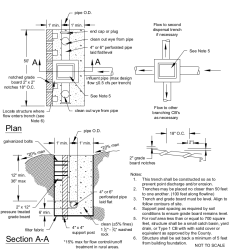4.3.2 Discharge Type and Location
-
If the 100‑year peak discharge, as estimated using an approved continuous runoff model using 15‑minute time steps, is less than or equal to 0.3 cubic foot per second (cfs) under existing conditions and will remain less than or equal to 0.3 cfs under developed conditions, then the concentrated runoff may be discharged onto outlet protection with riprap or to any other system that serves to disperse flows.
-
If the 100‑year peak discharge, as estimated using an approved continuous runoff model using 15‑minute time steps, is less than or equal to 0.75 cfs under existing conditions and will remain less than or equal to 0.75 cfs under developed conditions, then the concentrated runoff may be discharged through a dispersion trench (see Figure II-4.1) or other dispersion system (see Figure II-4.2), provided the applicant can demonstrate that there will be no significant adverse impact to downhill properties or drainage systems.
-
If the 100‑year peak discharge, as estimated using an approved continuous runoff model using 15‑minute time steps, is greater than 0.75 cfs for either existing or developed conditions, or if a significant adverse impact to downgradient properties or drainage systems is likely, then a conveyance system shall be provided to convey the concentrated runoff across the downstream properties to an acceptable discharge location (i.e., an enclosed drainage system or open drainage feature where concentrated runoff can be discharged without significant adverse impact).
Figure II-4.1. Dispersion Trench.

